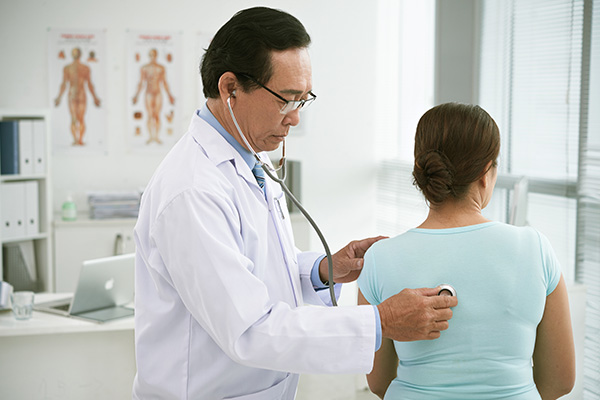In this article:
Pneumonia is a respiratory infection that causes irritation and inflammation of the air sacs in the lungs. This may involve either one or both lungs.

During pneumonia, the small air sacs, also known as alveoli, may fill up with infected fluid. The systemic manifestations of pneumonia are fevers, chills, productive cough, and dyspnea.
Patients have a hard time breathing. They usually may have difficulty walking long distances or carrying out their daily activities without running out of breath.
If they have underlying lung disorders such as chronic obstructive pulmonary disease (COPD), interstitial lung disease, or asthma, pneumonia can exacerbate those as well. (1)
Different Stages of Pneumonia
There are four stages of pneumonia:
- The first stage is congestion, which involves getting the infection and usually occurs in the first 24 hours of contracting the infectious agent. During congestion, the body experiences vascular engorgement and the lungs are usually inflamed. Capillaries in the alveoli wall become congested. During this stage, a person will experience coughing and deep breathing.
- The second stage is known as red hepatization, which usually occurs 2–3 days after congestion. At this point, the lungs are firm and red and resemble the liver. During this stage, vascular congestion in the alveolar capillaries persists. The alveoli fill up with electrolytes, neutrophils, and fibrin products, which cause inflammation.
- The third stage is known as gray hepatization, which occurs 2–3 days after red hepatization and is an avascular stage. During this stage, the lungs become dryer than usual and usually appear grayish-brown or yellow due to the disintegration of red blood cells.
- The final stage of pneumonia is resolution or complete recovery. This occurs when the exudate experiences progressive enzymatic digestion. This process produces debris that is eventually reabsorbed, ingested by macrophages, coughed up, or reorganized by fibroblasts.
Types of Pneumonia

Pneumonia is broadly classified into four categories based on how it is contracted:
- Community-acquired pneumonia occurs in a community setting other than a hospital, rehabilitation center, nursing home, or any other health care facility.
- Hospital-acquired pneumonia typically occurs during a hospital stay or at a health care facility such as a nursing home or rehabilitation center. It usually takes 48 hours after being admitted to the facility for it to occur.
- Ventilator-associated pneumonia occurs when a patient is on a mechanical ventilator for at least 48 hours.
- Aspiration pneumonia happens when food particles are accidentally inhaled into the lungs. The respiratory system of a young person is generally capable of clearing up any such accidental food inhalation, but this mechanism weakens with age, making it difficult to clear aspirated food, which eventually results in aspiration pneumonia. Aspiration pneumonia may also occur more commonly in alcoholics and those who have weak cough reflex, to name a few high-risk groups.
Causes of Pneumonia
The causes of pneumonia are various. Pneumonia can occur because of bacterial infection, which can be either typical or atypical. It can also occur due to fungal, viral, or parasitic infections.
Symptoms of Pneumonia
Symptoms of pneumonia can vary based on the severity of the underlying disease, which, in turn, depends on the underlying cause of infection as well as the overall health and age of the patient.
Typical symptoms of pneumonia include:
- Chest pain
- Fever and chills
- Productive cough or dry cough
- Sputum production
- Fatigue
- Sweating
- Shortness of breath and labored breathing
- Diarrhea
- Nausea and vomiting
Ways to Diagnose Pneumonia
Diagnosing pneumonia generally requires demonstration of capacity on chest imaging in the setting of a clinically appropriate syndrome such as fever, dyspnea, cough, and sputum production.
Appropriate history and physical examination help in recognizing the clinical syndrome, evaluating the severity, assessing complications, and identifying important exposures that may indicate further causes of infection. It also helps in assessing comorbidities that may be contributing to the symptoms.
Fatality of Pneumonia

Here are a few statistics that demonstrate how life-threatening pneumonia can be and the age groups most vulnerable to it:
- Pneumonia is the world’s leading cause of death among children under 5 years of age, accounting for 16% of all deaths of children under 5 years old, killing approximately 2,400 children a day. (2)
- There are about 120,000,000 episodes of pneumonia every year in children under 5 years, over 10% of which progress to severe episodes. (3)
- There was an estimated 880,000 deaths from pneumonia in children under the age of five in 2016. (4) Most of these were less than 2 years of age.
- In the United States, pneumonia is the most common cause of hospitalization for children.
- In adults, pneumonia is the most common cause of hospital admissions in the United States other than women giving birth. About 1,000,000 adults in the United States seek care in a hospital due to pneumonia every year and about 50,000 die from it. (1)
- While younger healthy adults have less risk of pneumonia, it is always a threat. Half of all the non-immune compromised adults hospitalized for severe pneumonia in the United States are adults between the ages of 18 to 57 years.
- Half of the deaths due to pneumonia are attributed to bacteremic pneumococcal pneumonia.
- Older people are at a higher risk of contracting pneumonia and are more likely to die from it. In the United States, seniors who are hospitalized for pneumonia have a greater risk of dying from this disease than any other comorbidity that they are admitted with.
- Pneumonia is also the most common cause of sepsis and septic shock, causing about 50% of all episodes. (5)
- Hospital-acquired pneumonia has a higher mortality rate than any other hospital-acquired infection.
Estimated Recovery Time for Pneumonia
The time of recovery from pneumonia depends upon several factors, which include the state of health of the individual, the severity of pneumonia, and the organism causing it. Most people recover within 1–2 weeks. Some take longer to recover.
Recommended Dietary Changes for Pneumonia Patients

Eating right can help speed up your recovery from pneumonia.
Dos:
- Drink plenty of fluids to keep your body hydrated.
- Consume protein-rich foods such as eggs, beans, nuts, seeds, white meat, and cold-water fishes that exhibit anti-inflammatory properties to bring down the swelling in your lungs. Plus, body tissue is primarily made up of protein, so these foods can also help in repairing damaged lung tissue and building new ones.
- Add more green leafy vegetables such as spinach, kale, and lettuce to your diet as they contain an array of nutrients that can help your body recover faster from the infection. They are especially loaded with antioxidants that help fight off free radicals and pathogens.
- Fruits, especially citrus fruits, are full of antioxidants, such as vitamin C, that strengthen your body’s disease-fighting prowess.
- Whole-grain foods are also good for people suffering from pneumonia.
Don’ts:
- Stay off dairy and sweets as they increase mucus production.
- Give up smoking and alcohol, both of which inhibit your body’s ability to fight the infection.
Precautions to Stay Safe From Pneumonia
Here are a few guidelines to avoid contracting or spreading pneumonia:
- Get vaccinated with influenza vaccine and pneumococcal vaccine.
- Quit smoking.
- Avoid contact with those who are infected with pneumonia.
- Wash your hands often.
- Sneeze or cough into a tissue or the bend of your arm.
Difference Between Viral and Bacterial Pneumonia
Bacterial pneumonia occurs due to a bacterial infection and sometimes it may cause septicemia. (6) In this case, blood cultures will be positive for the bacteria that have caused pneumonia. Sputum cultures also identify the type of bacteria that is causing pneumonia.
Antibiotics help in treating bacterial pneumonia. Viral pneumonia usually gets better on its own. However, viral pneumonia can lead to secondary bacterial pneumonia.
“Silent Pneumonia”: What Does It Mean?
Walking pneumonia or silent pneumonia usually occurs because of mycoplasma pneumonia. This form of pneumonia is so called because it sets in without any noticeable symptoms or respiratory distress and only becomes symptomatic once it reaches an advanced stage.
People suffering from silent pneumonia usually go about doing their daily activities without realizing they have the disease until much later. The only way to diagnose this condition is through a chest X-ray.
Most-Asked Questions About Pneumonia

How often should one get a pneumonia vaccine?
Children between the ages of 2 and 5 years are required to get 2 shots of pneumococcal vaccine, first when they are 12 weeks old and a booster dose when they turn 1.
Older adults aged 65 or above only need a single dose of pneumococcal vaccine, but certain preexisting health conditions may require them to get vaccinated every 5 years.
Does the pneumonia vaccine cause side effects?
The side effects outweigh the benefits, and therefore one should get vaccinated.
Can pneumonia be a symptom of an underlying medical condition?
Yes, pneumonia can be a symptom of another underlying lung condition. For example, post obstructive pneumonia can occur in those with an obstructive tumor in the lung.
Why are children more prone to pneumonia?
A child is more likely to get pneumonia if he or she has a weak immune system, chronic health problems such as asthma or cystic fibrosis, or any other airway disease.
In addition, children who are younger than 1 year are more likely to contract pneumonia if they are regularly exposed to secondhand tobacco smoke. This is especially true if their mothers are smokers.
Final Word
People should get vaccinated, practice good hygiene, quit smoking, avoid secondhand smoke, exercise regularly, eat a healthy diet, and get enough sleep to keep their immune system strong enough to combat pneumonia.
- Was this article helpful?
- YES, THANKS!NOT REALLY


